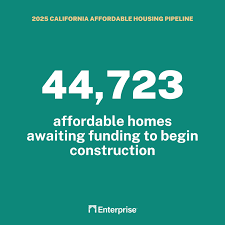Nearly 45,000 Affordable Homes in California Delayed Due to Funding Gaps

As of the end of 2024, Enterprise’s research found that 44,723 new affordable homes are in the near-construction pipeline and awaiting final funding. About 70% of the developments have applied to and secured some state funding, demonstrating the significant amount of time and resources already invested.
Furthermore, about 64% of the projects have already applied for Low-Income Tax Credits (LIHTC), and if they receive funding in the next round of awards, they would likely start construction within six months. These developments would serve an estimated 491,953 households over the next 55 years.
“To solve California’s affordable housing crisis, we need to unlock the development pipeline and scale funding to meet the need. Only then can we even begin to ensure every Californian has a safe and stable affordable place to call home,” said Heather Hood, Enterprise VP and Northern California market leader. “Our research demonstrates that California has invested significant time, energy, and resources into making affordable housing possible. I am confident that through prioritizing resources and strategies to prevent further delays, we can finish the job.”
“As Los Angeles recovers from the devastating wildfires from earlier this year, it is critical to provide the resources required to unlock the developments in the pipeline. The wildfires have exacerbated the housing crisis, further straining our limited housing stock,” said Jimar Wilson, Enterprise VP and Southern California market leader. “Communities across Southern California have experienced immense loss, and one of the most important ways California can respond now is through securing the funding required to build and preserve affordable housing.”
Unlocking Affordable Homes
The research found that to unlock the pipeline and move this housing forward, there is an estimated need for $1.79 billion in state subsidies and $574 million in state tax credits. Every dollar the state invests in affordable housing can leverage significant amounts of federal and private dollars. On average, the state contributes $167,328 in subsidies to each affordable home it funds. For every $1 of state funds invested in developments, $4 of private and federal funds are leveraged.
Enterprise’s report comes at a time when the Governor’s January Budget Proposal for 2025-2026 did not include funding for any of the state’s critical homelessness, affordable housing, and affordable homeownership programs. Without access to resources, California’s affordable housing pipeline will stall, undermining existing investments, and leaving more Californians without access to safe, affordable homes.
A statewide coalition of affordable housing, homelessness, and housing justice organizations has urged the Governor and the Legislature to scale affordable housing and homelessness investments to a minimum of $2.9 billion, only about 1% of the Governor’s proposed $229 billion general fund spending plan.
Securing Needed Resources
The report highlights three critical opportunities to secure much-needed resources to unlock the existing California housing pipeline.
Invest in ongoing state funding
- Fund affordable housing and homelessness programs in this year’s state budget.
- Pass a 2026 state affordable housing bond, as proposed in Assembly Bill 736 (Wicks) and Senate Bill 417 (Cabaldon).
- Protect funding for the Affordable Housing and Sustainable Communities Program (AHSC), funded through the state’s Greenhouse Gas Reduction Fund (GGRF), which invests in high-impact, integrated projects that include affordable housing, transportation, urban greening, and community programming.
- Create a permanent and consistent source of investment for affordable housing to meet the state’s needs.
Curb costs by addressing system inefficiencies
- Better coordinate the state’s housing finance system, including the creation of a single, unified funding application and a waitlist and off-ramp for federal resources. The current system requires developments to apply to multiple state housing finance agencies to access subsidies, bonds, and tax credits. This leads to many inefficiencies, adds additional costs and further delays the development of needed affordable homes.
- Advocate for the reorganization of the state’s housing agencies into one entity, The California Housing and Homelessness Agency, as previewed in the Governor’s January Proposal. While the details of the proposal are not known yet, this timely and important opportunity could strengthen California’s ability to plan, produce and preserve affordable housing.
Expand the federal housing credit
- Pass the Affordable Housing Credit Improvement Act (AHCIA), effectively expanding and strengthening the Low-Income Housing Tax Credit (LIHTC). Enacting the provisions in the AHCIA would lower the pipeline’s need for tax-exempt bonds from $9.1 billion to $4.5 billion. In practice, this would dramatically increase access to federal 4% LIHTC in California, which is available on an as-needed basis to qualifying developments with tax-exempt bonds.
- Engage federal lawmakers to ensure affordable housing remains a priority in federal negotiations.





